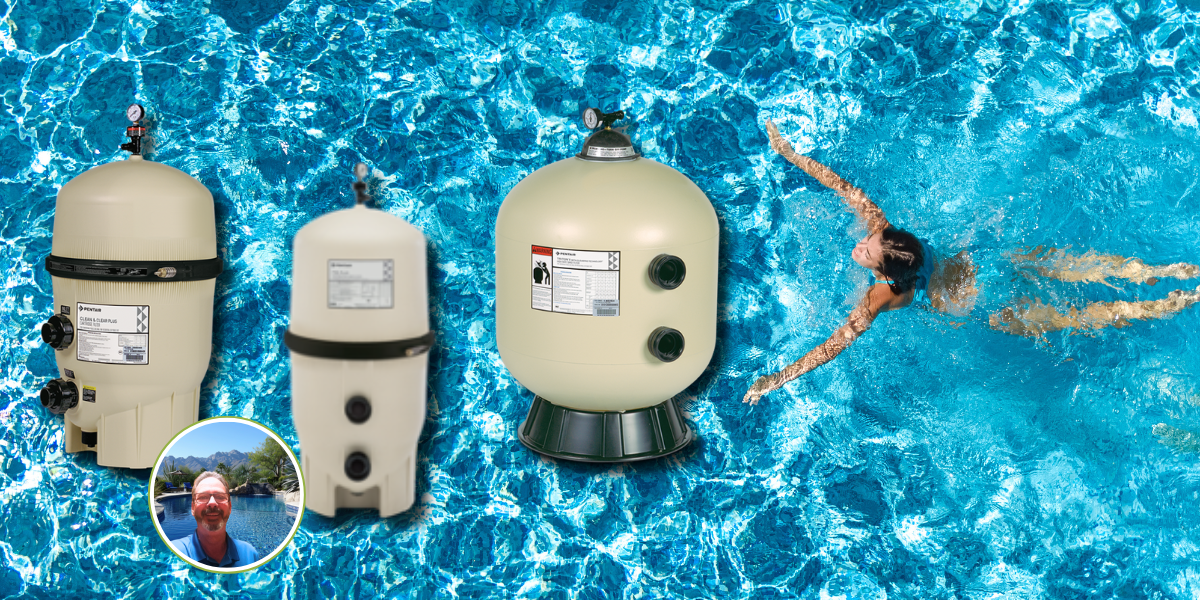The Importance of Proper Pool Filtration for Arizona Swimming Pools
Proper pool filtration keeps Arizona pools safe, clear, and inviting. Learn the differences between cartridge, sand, and DE filters—and discover which system is best for your backyard oasis.

Owning a swimming pool in Arizona is a luxury that requires consistent care. With our desert climate, pools are exposed to dust storms, fine debris, heavy sunlight, and high bather loads during the swim season. While chemical balance keeps the water safe, filtration is the backbone of clean, sparkling water. Without the right filter system, even the best pool maintenance schedule will fall short.
In this post, we’ll break down the three main types of swimming pool filters—cartridge, sand, and diatomaceous earth (DE)—and explain how each works, along with their pros and cons.
Why Filtration Matters
Your pool filter’s job is simple: remove dirt, debris, and microscopic contaminants from the water. Sunscreen, body oils, dust, and algae spores are constantly introduced into Arizona pools. If not captured and removed, they cloud the water, strain your sanitizer, and create an unpleasant swimming environment.
Proper filtration:
- Keeps the water crystal clear.
- Reduces chlorine demand.
- Protects pumps and heaters from clogging.
- Extends the life of your pool’s interior finish.
Choosing the right filter makes a measurable difference in both water quality and maintenance time.
Ready to upgrade your pool filtration system?
Don’t settle for cloudy water. Whether you’re considering a cartridge, sand, or DE filter, we’ll help you choose the perfect solution for your Arizona pool.
👉 Request Your Free Quote Today and enjoy crystal-clear swimming all year long.
Pool Filter Comparison Chart
| Feature | Cartridge Filter | Sand Filter | DE (Diatomaceous Earth) Filter |
|---|---|---|---|
| Filtration Level | 10–15 microns (fine) | 20–30 microns (moderate) | 2–5 microns (ultra-fine) |
| Water Clarity | Very clear | Fair to good | Crystal clear (resort quality) |
| Maintenance | Remove & hose cartridges clean | Backwash required | Backwash + re-add DE powder |
| Water Usage | Low (no backwashing) | High (uses water during backwash) | Moderate (backwash + DE recharge) |
| Cost | Mid-range | Lowest upfront | Highest upfront & ongoing |
| Lifespan | Cartridges: 2–3 years | Sand: 5–7 years | Grids: 7–10 years (with upkeep) |
| Best For | Water conservation, efficiency | Budget-friendly, simple operation | Maximum clarity, high-end performance |
Cartridge Filters
How They Work
Cartridge filters use pleated polyester cartridges to trap debris as water flows through. Think of them as oversized air filters, but designed for water.
Pros
- Filter down to 10–15 microns (very fine).
- Require no backwashing—just remove the cartridges and hose them off.
- Save water, making them ideal for Arizona where conservation matters.
- Provide a large filter surface area, which reduces pressure and energy use.
Cons
- Cartridges must be cleaned regularly, especially during monsoon season.
- Need to be replaced every 2–3 years depending on use.
Best For
Homeowners who want excellent water clarity with low water waste. Cartridge filters are increasingly popular in Arizona because of drought conditions and efficiency.
Sand Filters
How They Work
Sand filters use specially graded pool sand to trap debris as water passes through. As dirt collects, pressure builds, and the filter is cleaned by backwashing—reversing the flow to flush debris out.
Pros
- Simple to operate and maintain.
- Typically the most affordable filter type.
- Durable, lasting 5–7 years before sand replacement.
Cons
- Filter only down to 20–30 microns (less fine than cartridge or DE).
- Require backwashing, which uses hundreds of gallons of water each time.
- Larger water waste makes them less environmentally friendly in Arizona.
Best For
Budget-conscious pool owners who value ease of use over water clarity.
Diatomaceous Earth (DE) Filters
How They Work
DE filters use a fine powder made from crushed fossilized algae (diatomaceous earth) coated onto filter grids. They provide the highest level of filtration available in residential pools.
Pros
- Filter down to 2–5 microns (the finest filtration of all).
- Deliver unmatched water clarity—your pool will look polished.
- Effective for pools with high debris loads.
Cons
- Require more frequent maintenance, including backwashing and recharging with DE powder.
- DE powder must be handled carefully and replenished regularly.
- Typically the most expensive option upfront and ongoing.
Best For
Owners who demand crystal-clear water and are willing to perform extra maintenance.
Which Filter Is Right for You?
- Cartridge Filter – Ideal if you want low maintenance and water savings, especially in Arizona’s drought conditions.
- Sand Filter – A good entry-level option for simplicity and affordability, but with lower clarity.
- DE Filter – Perfect if you want “resort-quality” clarity and don’t mind extra upkeep.
Ultimately, the best choice depends on your priorities: cost, clarity, water conservation, and maintenance commitment. Many Arizona pool owners are shifting toward large cartridge filters because they balance efficiency and performance without wasting water.
Final Thoughts
A swimming pool is one of the best lifestyle investments you can make in Arizona. But the difference between a cloudy pool and a sparkling one often comes down to your filter. Whether you choose cartridge, sand, or DE, keeping your system clean and properly maintained ensures your water stays safe, clear, and inviting year-round.
Ready to upgrade your pool filtration system?
Don’t settle for cloudy water. Whether you’re considering a cartridge, sand, or DE filter, we’ll help you choose the perfect solution for your Arizona pool.
👉 Request Your Free Quote Today and enjoy crystal-clear swimming all year long.
